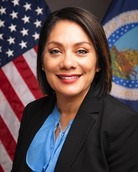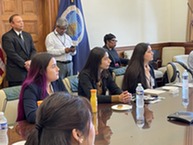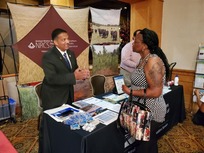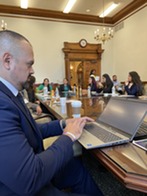|

Welcome to the first newsletter of the Office of Partnerships and Public Engagement (OPPE). The U.S. Department of Agriculture (USDA) OPPE has the great privilege of touching the lives of rural and historically underserved communities, with the goal of improving the quality of life for people around the country.
The OPPE develops and maintains partnerships focused on solving challenges facing rural and underserved communities in the United States, and connects those communities to the education, tools, and resources available to them through USDA programs and initiatives.
The Office of Partnerships and Public Engagement is here to share information regarding USDA resources, grants and programs with new farmers, underrepresented farmers, veterans, students, community nonprofits, and higher education institutions. We provide equitable access to USDA resources from all our agencies. We encourage you to sign up to receive future newsletters and other targeted information relating directly to your interests.
|
|
|

USDA Offers Financial Assistance for Farm Loan Borrowers who Faced Discrimination
Section 22007 of the Inflation Reduction Act (IRA) provides $2.2 billion in financial assistance for farmers, ranchers and forest landowners who experienced discrimination in USDA’s farm lending programs prior to January 1, 2021. The program complements other assistance made possible through the IRA, including assistance for distressed borrowers. We encourage you to find out more.
USDA Advisory Committee on Minority Farmers
The Advisory Committee on Minority Farmers (ACMF) works to ensure that all farmers have equal access to USDA programs. The ACMF committee met from June 27-29, 2023 in Savannah, GA. ACMF meeting minutes will be available on the Advisory Committee on Minority Farmers web page.
|
|
|

100 USDA/1890 Scholars Selected
USDA recently awarded 97 USDA/1890 National Scholarships. The USDA/1890 National Scholars Program is a partnership between USDA and the 19 historically Black land-grant universities. This program is one of USDA’s many efforts to increase the number of minorities studying and working in agriculture, food, natural resource sciences and related disciplines, and to achieve a workforce that reflects the diversity of the communities USDA serves. Scholarships are available to students entering their freshman year of college as well as rising college sophomores and juniors.
We encourage you to read about 1890 National Scholar Allison Malone's journey to become a civil engineer with USDA's Natural Resources Conservation Service agency, where she is currently working to help America’s farmers, ranchers and forest landowners conserve the nation’s soil, water and air.
|
|
|

USDA Welcomes 2023 E. Kika De La Garza Fellows
USDA recently welcomed 30 faculty and staff from Hispanic-Serving Institutions (HSIs) around the country as the 2023 class of E. Kika De La Garza Fellows to Washington, D.C. The E. Kika De La Garza Fellows spent one to two weeks learning about USDA programs and services that can benefit them and their students.
Read about Sandya Kesoju, one of last year's fellows who is using the information she received during her visit to the nation's capital to prepare the next generation of agriculture and STEM scientists.
OPPE to Host Virtual HSI Federal Resources Symposium
On September 21, 2023 from 11 a.m. - 2 p.m. EST, the HSI community and partnering stakeholders are invited to hear from Departmental leaders, program officers, and project coordinators about a variety of federal funding resources offered at USDA and other federal agencies. These resources are aimed at helping institutions expand research development and experiences for faculty and students at HSIs across the country. This includes learning about how USDA supports student research opportunities at various agencies within the Department with grants, partnerships and other collaborations. Register here for this virtual event.
|
|
|

HEP/CAMP Interns Complete Summer Internships
Eight students from migrant and farmworker backgrounds participated in paid summer internships with USDA agencies in Washington, DC. These agencies included the Farm Service Agency and Natural Resources Conservation Service. The students gained gained work experience and learned about career opportunities with USDA. USDA sponsored these opportunities in partnership with The National HEP/CAMP Association.
|
|
|

2501 Grants to be Announced
This year's 2501 Grants application submission window closed on July 25, 2023. Applications are currently being reviewed, and grant awardees will be announced in September. Register now for the two-day Partnership Symposium scheduled for September 27-28 in Austin, TX!
Find out how an earlier 2501 grant is helping make agricultural resources and training more accessible to farmers who do not use English as a first language.
|
|
|

USDA Helps Veterans Find Careers after Service
Military Veterans Agricultural Liaison (MVAL) Monshi "Ram" Ramdass (left, at a recent career fair) helps veterans find the resources and training they need to start second careers after their military service. Check out these recent success stories:
-
John Langdon works as a project coordinator with the U.S. Forest Service.
-
Tray Middlebrooks is a loan specialist with USDA Rural Development.
-
Michael Reese has started a new career as a travel and transportation specialist at USDA Rural Development.
Ram also connects vets to USDA grantees who offer training in farming and ranching, opening up opportunities for fulfilling careers in agriculture.
Visit the Veterans web page for more information.
|
|
|

Julio Puentes
USDA champions Hispanic outreach
USDA’s Hispanic Serving Institution National Program (HSI-NP) was created in 1996 to partner with Hispanic Serving Institutions, or HSIs, across the country. These public colleges and universities have a student body that is at least 25 percent Hispanic.
Julio Puentes, foreground, manages this program with a team of USDA liaisons who work closely with their assigned HSIs to provide increased professional development, workforce development, and exposure opportunities for faculty, staff and students. There are currently more than 500 HSIs nationally, serving more than 2 million students.
|
|
|
News for Grant Applicants
On April 4, 2022, the unique entity identifier used across the federal government changed from the DUNS Number to the Unique Entity ID (generated by SAM.gov). The Unique Entity ID is a 12-character alphanumeric ID assigned to an entity by SAM.gov. As part of this transition, the DUNS Number has been removed from SAM.gov. Entity registration, searching and data entry in SAM.gov now require use of the new Unique Entity ID.
Existing registered entities can find their Unique Entity ID by following the steps here. New entities can get their Unique Entity ID at SAM.gov and, if required, complete an entity registration. You can search for help through the Federal Service Desk (FSD) any time or request help from an FSD agent Monday–Friday 8 a.m. to 8 p.m. ET online or at (866) 606-8220.
|
|
Help Children and Families Retain Health Coverage
After a three-year pause during the pandemic, states are restarting their regular review of individuals’ Medicaid and Children’s Health Insurance Program (CHIP) eligibility to determine if they still qualify for coverage. To ensure that eligible children and families retain coverage, we encourage parents and guardians to:
- Make sure their state Medicaid or CHIP agency has their current contact information.
- Check the mail for the Medicaid/CHIP renewal form when it arrives.
- Complete and return the form right away to avoid a gap in coverage.
Individuals ineligible for Medicaid or CHIP can see if they are eligible for Marketplace coverage by visiting HealthCare.gov or calling (800) 318-2596.
Together, we can make sure our communities have access to quality, affordable health coverage. For additional resources to help keep children and families covered, visit this Medicaid webpage for more information.
 |
|
Did You Know...
... That USDA’s Agricultural Marketing Service employs architects who help communities design their farmers markets?
|
|
|
|
|
|